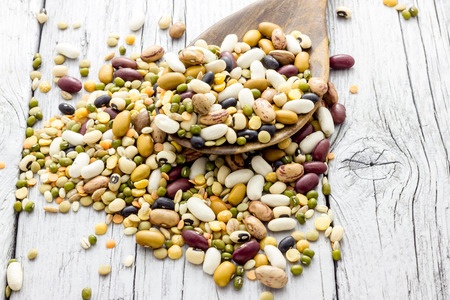
Product developers are always seeking new ingredients that will offer the consumer something delicious, nutritious and exciting. Pulses come to mind when finding suitable protein alternatives that are for vegans and vegetarians, gluten-free, generally very low allergenicity if any, non-GMO and sourced sustainably. The current trend for vegetable proteins remains unabated simply because they offer versatility, a clear differentiation and that insatiable demand consumers have for something new. Many of FoodWrite’s clients regularly ask what pulse derived proteins might do for them in turning customers to their products. We often examine the role of these ingredients in various products and this article shares some of those current thoughts we have.
Pulses refer to legumes. These are beans (fava, mung, broad) and peas, lentils, chickpeas and the list carries on but note – not soya. They have been especially important in developing countries as they provide about 10% of the total dietary protein. They are plant products which can be sustainably resourced, rely on less energy especially the non-renewables and actually fix nitrogen in the soil. Vegetable growers find them ideal for replenishing the soil of lost nitrogen and are a great crop to grow just for that purpose alone.
Historically, the word suggests their product development use. Pulse is a derivation of the latin word puls or pultis which meant ‘thick soup’.
Market Research With Pulse Ingredients
Our own insights come from customers seeking proteins for new product opportunities in satiety and weight loss, and in sports nutrition. Along with protein comes the added benefits of fibre and a cleaner label which other protein derived ingredients often lack.
Innova Market Insights in 2015 examined the steady rise in both sales and product launches where pulses had been placed in the spotlight. The grocery retailer Kroger reported pulse ingredients had a 34% household penetration over the year from April 2014 to March 2015. From 2010-2013, there was a general increase of 74% in new product launches using pulse ingredients throughout the market. Innova also reported specific ingredients like pea protein reached 50% YOY (year on year) sales growth whilst chickpea flour enjoyed a 155% YOY sales growth.
The global importance is such that the United Nations declared 2016 the Year of the Pulse.
Product Development Opportunities
Pulse ingredients offer some clear labelling opportunities. We have suggested to clients how they can label their products as are non-GMO and gluten-free and refer to their high or rich in protein content. The amino acid lysine is also prevalent and worth highlighting as is the dietary fiber and various micronutrients which help develop their product’s story. From a heart or satiety point of view we find pulse ingredients have a low enough glycaemic index to make serious nutritional sense.
Pulses ingredients which mainly cover their flours and proteins are usually added to baked goods, especially breads, crackers, biscuits and cookies. We have developed sports bars with 8, 10 and 18%w/w protein using pea or combinations of these legume derived proteins as a way of demonstrating the opportunities.
Suppliers like Ingredion and AGT Foods offer concentrates with 55-60% protein, or fine to course grade flours derived from peas, broad, navy and fava beans, lentils or chickpeas.
Functional Properties
The sort of functional properties that pulse ingredients provide are the following:-
- emulsification,
- gelation and gelling
- texture,
- water-holding,
- adhesion and film forming.
They can be used in formulations to raise protein in a recipe or to reduce even eliminate other proteins such as egg whites, dairy proteins or other soy proteins.
They offer suitable synergy with other gluten-free flours by modifying their properties to enhance moisture retention and improve texture. In gluten-free bakery and snack applications for example, pulse flours and proteins can be used along with other gluten-free flours, providing moistness, colour, texture and structure. For vegans especially as well as gluten-free dishes, they are the ideal replacement for egg white in a range of dishes including pasta.
An Ingredion seminar in 2017 given by Bicheng Wu, PhD, associate-Global Applications at Ingredion commented on further recipes and applications :-
“In chicken gravy, pulse flour made from lentils or faba beans, along with native functional starch, withstood freeze-thaw cycles and maintained consistent viscosity and homestyle appearance. Sensory scores showed no significant differences to those of the wheat flour control gravy in terms of texture and flavour.”
For example, in a gluten-free pizza formulation, pulse flours can be used along with other gluten-free flours to provide more open cell structure, balancing chewiness with crispy crust. In addition, egg whites in the formula were removed leading to a formula cost reduction. Pulse flours can be a one-to-one replacement for wheat flour in soup and sauce applications.
Wu also described gluten-free batters and breading for chicken from a variety of pulse flours which provided even coverage, good appearance, light crispy texture, lower cost and better nutrition (8% DV iron and 4% DV fiber) than traditional gluten-free solutions. We know from personal experience that gluten-free batter and breading mixes also can be formulated with various pulse proteins and flours. This provides a boost to the protein content while contributing to structure, as well as giving binding and adhesion.
Gluten-free products don’t always brown properly. Pulse flours and proteins have a tendency of browning in the presence of reducing sugars, because their high lysine content acts as a substrate for the Maillard browning reactions. Therefore, they can be successfully used in gluten-free bakery applications to provide colour.
When it comes to beverage development which is a strength for FoodWrite incidentally, Ingredion have clearly tried pulse ingredients. For example they consider that mango smoothies with lentil protein can provide 16g of protein per serving, with clean flavour and smooth texture.
To conclude, pulse derived ingredients provide many nutritional and labelling benefits. They have a clean flavour and offer functional versatility. The number and variety of applications is expanding all the time.

I use a lot of pea and bean flour in my cooking. It sometimes has a very strong flavour which tells me that it shouldn’t be used in too great a quantity. The more expensive pea ingredients for some of my vegan recipes are almost free of that beany note. Hoping that some of the suppliers out there can bring the price down – it is hampering the cost of product development because the basic ingredient costs are still too high.